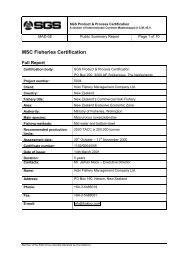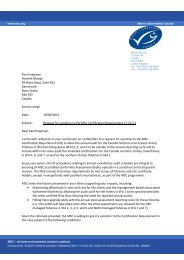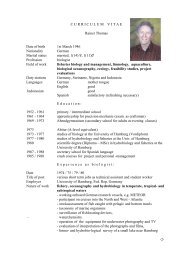SGS Product & Process Certification - Marine Stewardship Council
SGS Product & Process Certification - Marine Stewardship Council
SGS Product & Process Certification - Marine Stewardship Council
Create successful ePaper yourself
Turn your PDF publications into a flip-book with our unique Google optimized e-Paper software.
Scoring criteria Scoring guidepost 60 Scoring guidepost 80 Scoring guidepost 100<br />
2.4.3 Information /<br />
monitoring:<br />
Information is<br />
adequate to determine<br />
the risk posed to<br />
habitat types by the<br />
fishery<br />
and the effectiveness<br />
of the strategy to<br />
manage impacts on<br />
habitat types.<br />
(1-60) There is a basic<br />
understanding of the types and<br />
distribution of main habitats in<br />
the area of the fishery.<br />
(2-60) Information is adequate to<br />
broadly understand the main<br />
impacts of gear use on the main<br />
habitats, including spatial extent<br />
of interaction.<br />
(1-80) The nature, distribution<br />
and vulnerability of all main<br />
habitat types in the fishery area<br />
are known at a level of detail<br />
relevant to the scale and<br />
intensity of the fishery.<br />
(2-80) Sufficient data are<br />
available to allow the nature of<br />
the impacts of the fishery on<br />
habitat types to be identified and<br />
there is reliable information on<br />
the spatial extent, timing and<br />
location of use of the fishing<br />
gear.<br />
(3-80) Sufficient data continue to<br />
be collected to detect any<br />
increase in risk to habitat (e.g.<br />
due to changes in the outcome<br />
indicator scores or the operation<br />
of the fishery or the<br />
effectiveness of the measures).<br />
(1-100) The distribution of<br />
habitat types is known over their<br />
range, with particular attention to<br />
the occurrence of vulnerable<br />
habitat types.<br />
(2-100) Changes in habitat<br />
distributions over time are<br />
measured.<br />
(3-100) The physical impacts of<br />
the gear on the habitat types<br />
have been quantified fully.<br />
Scoring comments<br />
The North Sea is the most intensively investigated sea area in the world. Generations of zoologists, botanists and hydrographers — and more<br />
recently microbiologists, meteorologists, climatologists, chemists, pathologists and toxicologists — have produced an impressive body of<br />
knowledge (Kinne, 1995).<br />
The nature, distribution and vulnerability of all main habitat types in the fishery area are known at a level of detail relevant to the scale and<br />
intensity of the fishery (1-80).<br />
The distribution of North Sea bottom habitat types and their sensitivity for bottom impacts such as trawling has been investigated in detail.<br />
Sufficient knowledge is available to allow the nature of the impacts of a rod and line fishery on different types of sea bottom (sand, gravel or<br />
Page 88 of 151





